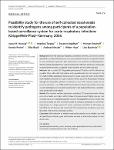Feasibility study for the use of self‐collected nasal swabs to identify pathogens among participants of a population‐based surveillance system for acute respiratory infections (GrippeWeb‐Plus)—Germany, 2016
Haussig, Joana M.
Targosz, Angelina
Engelhart, Susanne
Herzhoff, Michael
Prahm, Kerstin
Buda, Silke
Nitsche, Andreas
Haas, Walter
Buchholz, Udo
Background
Internet‐based participatory surveillance systems, such as the German GrippeWeb, monitor the frequency of acute respiratory illnesses on population level. In order to interpret syndromic information better, we devised a microbiological feasibility study (GrippeWeb‐Plus) to test whether self‐collection of anterior nasal swabs is operationally possible, acceptable for participants and can yield valid data.
Methods
We recruited 103 GrippeWeb participants (73 adults and 30 children) and provided them with a kit, instructions and a questionnaire for each sample. In the first half of 2016, participants took an anterior nasal swab and sent it to the Robert Koch Institute whenever an acute respiratory illness occurred. Reporting of illnesses through the GrippeWeb platform continued as usual. We analysed swabs for the presence of human c‐myc‐DNA and 22 viral and bacterial pathogens. After the study, we sent participants an evaluation questionnaire. We analysed timeliness, completeness, acceptability and validity.
Results
One hundred and two participants submitted 225 analysable swabs. Ninety per cent of swabs were taken within 3 days of symptom onset. Eighty‐nine per cent of swabs had a corresponding reported illness in the GrippeWeb system. Ninety‐nine per cent of adults and 96% of children would be willing to participate in a self‐swabbing scheme for a longer period. All swabs contained c‐myc‐DNA. In 119 swabs, we identified any of 14 viruses but no bacteria. The positivity rate of influenza was similar to that in the German physician sentinel.
Conclusion
Self‐collection of anterior nasal swabs proofed to be feasible, was well accepted by participants, gave valid results and was an informative adjunct to syndromic data.
Dateien zu dieser Publikation

